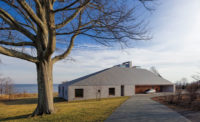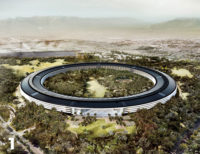The architecture has evolved, joining design with support services.
Over the last five decades, models for social housing in U.S. cities have continually evolved. First, the postwar subsidized brick high-rises—based on Le Corbusier's towers-in-the-park of the 1920s—were largely abandoned. Then, starting in the 1970s, smaller infill developments, often mimicking a neighborhood's rowhouses, were increasingly adopted. But low-rises with separate entries and limited communal space have not been able to serve all the needs of some populations, such as the elderly, disabled, or formerly homeless.
More and more, architects, planners, and community activists are recognizing that housing for growing low-income and special-needs urban populations should be flexible. It has to accommodate single adults (young and old), single-parent families, and multigenerational clans bunking together. Furthermore, housing experts maintain that social and community services are as essential to the success of public housing as building design.
And so a new prototype is emerging: mid-rise apartment buildings that maintain the street wall, achieve a desirable density, and better meet the needs of the communities they serve. Actually, this type of housing has been part of middle-class city neighborhoods since before World War II—but it was aimed at the private market. The important shift today is recognizing that it should go hand in hand with a strong social agenda.
In talking to advocates and architects, it becomes clear that low-income housing must be integrated into a healthy neighborhood; that it must accommodate a variety of household configurations; and that it should project the dignity and interior warmth of market-rate architecture. And it needs to feel safe. “Defined, observable open space with a clear definition of entries to a building leads to a sense of security,” says Theodore Liebman, a principal at Perkins Eastman who was chief of architecture for the New York State Urban Development Corporation from 1971 to 1975. “But crime reduction in public housing is as much about active street life as the design of buildings.”
Hallways inside the buildings can be dangerous as well, points out Deborah Gans, principal of Gans Studio in New York City and a professor of architecture at Pratt Institute in Brooklyn. Gans advocates an “eyes on the hallway” design approach as the interior equivalent of Jane Jacobs's famous “eyes on the street” formulation. If a window looks onto the hallway from an apartment's kitchen, parents can cook and still see kids playing in those corridors. Liebman notes that buildings should locate laundry rooms next to children's playrooms, with a window from one to the other, so parents can keep an eye on their kids while doing the wash.
Twenty-first-century social networks differ from the norm that guided designers in the urban-renewal building boom of the 1950s and '60s. During those years architects conceived of public housing as shelter for two-parent nuclear families. But today's low-income households are frequently headed by a single mother who needs child-care support. “You have to do a careful analysis of how people live,” says Gans. “If the single parent works in three jobs, who's going to take care of the kids?” Many families rely upon grandparents for child care, or, sometimes, a steady flow of relatives arriving from a home country. In many cases, these communities have three generations under one roof where extended-family members come and go. “Maybe it's good to have a grandma unit on one floor and yours on another,” suggests Gans.
Unlike wealthier families, people in public housing usually depend on the community for such amenities as gyms and after-school and summer activities for children. Architects are increasingly concerned about whether there is a well-designed public park in close proximity to the housing complex, or at least an attractive interior courtyard or community garden within its confines.
In addition, multigenerational family living requires more than simply making apartments bigger. Michael Pyatok, principal of Pyatok Architects in Oakland, who has been specializing in affordable housing for several decades, points out that including space for grandparents or adult children is different from building an apartment with the same number of rooms for a family with kids. “The best way to accomplish this cohabitation by different generations is to separate the bedrooms at opposite ends of an apartment or put them on separate floors of a townhouse,” says the architect, who is a winner of the American Institute of Architects' 2013 Thomas Jefferson Award for Public Architecture.
Architects today seek to destigmatize public housing with designs that fit into the surrounding urban realm, both in scale and in interaction with the street. They can also employ subtler elements—such as materials and detailing—not typically associated with low-income housing.
“My goal is to make the new structure look like housing, period,” says New York architect Jonathan Kirschenfeld, who often designs single-room-occupancy supportive housing for recently homeless or mentally ill residents. “We use iron-spot brick for every exterior, which is traditionally identified with solid 1930s and 1940s good urban fabric. We spend a lot of time finessing the facade: windows are punched, compositions carefully calibrated.”
Historically, housing projects have been known for uninviting double-loaded corridors lit with harsh or flickering fluorescent fixtures. Kirschenfeld and other architects include lot-line windows at the end of each corridor to bring daylight into the hallways. At the Hegeman (page 102), a mix of supportive and low-income housing in Brownsville, Brooklyn, the architect, CookFox, introduced daylight into the lobby by placing glazed entrance walls across from the elevator in the middle of an L-shaped building.
The designs of a number of recent projects reflect current thinking about the importance of offering social and community services to residents—so placing those amenities with care is a priority. And while ground-floor shops in apartment blocks might seem ideal for generating activity in the neighborhood, rooms providing social services or amenities also help create engagement with the street. “Often, affordable housing is in an economically challenged neighborhood where the location may not be great for retail,” says Richard Stacy, a partner at the San Francisco firm Leddy Maytum Stacy Architects, which has designed many affordable-housing projects in the Bay Area. “So what we do instead is place community spaces—the common room, computer room, and gym—along the street, where they offer built-in casual surveillance,” as demonstrated by his firm's Merritt Crossing Senior Apartments in Oakland.
Common Ground, a nonprofit organization that built and manages the Hegeman in Brooklyn and the Brook in the Bronx (designed by Alexander Gorlin), reinforces community engagement by providing classes in everything from résumé writing to knitting for residents, and sometimes for anyone from the neighborhood. While public housing originally addressed a perceived housing shortage, advocates and architects now understand that problems such as homelessness are social issues, requiring social solutions. Common Ground's supportive housing includes on-site case management, with staffers, including medical personnel, who are available to meet with residents having problems. “We have big buildings because we set the bar high on programming and staff, and in order to do that you need economies of scale,” explains Brenda Rosen, executive director of Common Ground.
Incorporating various activities into a housing complex to help generate economic opportunities is advocated by Rosanne Haggerty, who founded Common Ground and, in 2011, began Community Solutions, also a New York nonprofit focused on affordable housing. Inspired by The Stop, a community food center in Toronto, Community Solutions is developing a 2.5-acre site in Hartford, Connecticut, that contains an abandoned 65,000-square-foot 19th-century factory. The organization plans to build housing and a library, plus a community food center with classes in cooking and nutrition as well as a commercial kitchen that residents can rent for their food-related businesses. Nearby will be a community garden. “You need to create optimism and hope for people who are living from crisis to crisis,” says Haggerty. “Design once contributed to the problem, but it can now contribute to the solution.”












Post a comment to this article
Report Abusive Comment